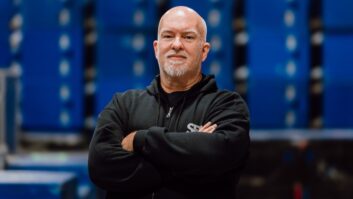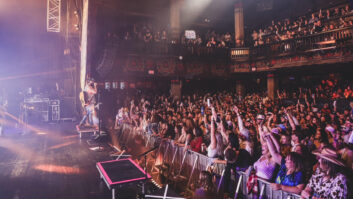
Jason Aldean and band at Sanford Stadium, University of Georgia
Photo: Chris/Todd Owyoung
Jason Aldean puts on a rock ’n’ roll show. The roots are in country, but the approach and delivery is straight-up guitar-bass-drums, with wide dynamics and big sound. It wasn’t that long ago that long days in a van were followed by shows for maybe 100 people in a club. But since his rise that began in 2009 and exploded in 2010 with My Kinda Party, he’s been a sold-out headliner. On this month’s cover, taken in late April 2013, he played to 68,000 in the first-ever music event in Sanford Stadium on the University of Georgia campus, not far from his hometown of Macon.
“There’s a joke on the tour that the only thing country about this band is Jason’s hat,” says monitor engineer Evan Richner, a Cleveland native who has been with the crew since a fortuitous call from a former roommate and subsequent move to Nashville in 2005. “We have a bass player with tattoos coming out of his sleeves! It is very high energy.”
“This is a real band, playing together, and they have been for a long time,” adds FOH engineer Chris Stephens, who joined the team in the summer of 2009, right before going out as an opener for the Brooks & Dunn farewell tour. “Jason is a great singer, but the energy of the show comes from the whole band and the way they interact. There are no tracks on this tour. Everyone in the band is incredibly talented and that makes my job much easier.”
The core of the band—Aldean, guitarist Kurt Allison, bassist Tully Kennedy and drummer Rich Redmond—have been intact for a decade. They play together in the studio and on the road, having developed a rapport that comes across onstage. They are known to make Platinum-selling records with only a few days of tracking and a couple of weeks to mix.
Getting Big
Aldean started his first real headline tour in January 2010, and by the second night, looking at the speed of ticket sales, they knew they had to bring in a larger P.A. immediately. Tour sound provider Spectrum Sound of Nashville was providing a d&b audiotechnik J-Series rig, so they just made it bigger. Today, the arena dates on the tour (way larger for football stadiums, slightly larger for Wrigley Field, Fenway Park) consists of (40) J8s for the main hang, (32) J12s side hang, (16) flown J-Subs, (18) ground J-Subs, (8) Q10 front fills, (74) D12 amplifiers. Control is via Lake LM44 speaker processing and distribution.

From L to R, at the Avid Profile: Spectrum P.A. tech Bob Campbell, FOH engineer Chris Stephens and crew chief/system engineer Jeremy Seawell
Photo: Kevin Twist
According to Stephens, the rapid growth in size of venues didn’t lead to much of a change in the style of mixing, mainly because of the way the band plays and the choice of d&b rig. “The P.A. provides a level of consistency that doesn’t require me to start over or make drastic changes when we move from small clubs and promo shows to stadiums,” he says. “The way the P.A. scales, we can go from a small groundstack array to a stadium hang and feel comfortable that we are providing a consistent sound. I have been working off the same show file, with a few changes, for the past three years. Honestly a lot of P.A.s are so good now; it’s mostly preference, like picking a vocal mic.”
Stephens grew up in Knoxville, Tenn., mentored by Mike DeFreece in a megachurch through middle and high school and later attended Belmont University. When he graduated, he began working with Spectrum Sound; very shortly after, he was mixing FOH for Wynonna. Then he spent two years mixing monitors for Michael McDonald. Now he’s with Jason, among other artists.
For Aldean, he mixes at an Avid Profile, which he has been familiar with since it came out. About a year-and-a-half ago, they modified the front end. “We’re using Midas XL8 preamps, the DL431,” he explains. “The splitter outputs AES50 to a format converter, then MADI into the Avid input card. The change to the sound was incredible. And then you also get the Profile processing and mixing power. It really gives us the best features of both systems.” The same is done for the monitor mix, with Midas DL451 output converters between the Profile and the in-ears.
Effects and tools are mainly in the box, with Waves V9, SPL Transient Designer, Crane Song Phoenix, Massey De:sser, Rane Serato, Rational Acoustics Smaart v.7 and the like. But this is definitely an act, whether studio or live, that believes it all begins up front, at the mic. The band had already been working with Audio-Technica when Stephens came onboard, and after initial skepticism, the team feels confident they have matched the best mics to specific instruments in specific places, over many years, fine-tuning all along. It’s essentially a studio philosophy of micro-movement of the mic rather than micro or massive EQ and processing.
“This show is really guitar-heavy,” Stephens explains. “I have an A-T 4081 ribbon and Shure SM57 on each guitar cabinet panned slightly to either side, then add slight delay at the console to phase-align the two mics. I EQ guitars barely at all. Highpass filter, that’s about it. The right mics in the right place, and we get a nice wide image with plenty of space for the vocal. Jason’s vocal mic is an Audio Technica AE6100, which is processed by a Massey De:Esser, Rvox, to CLA-2A, to C6 multiband compressor to Hybrid EQ. I only use the H-EQ if he jumps on the thrust. I try my best to listen first and not make knee-jerk reactions. You can really dig a mix into a hole by relying on EQ. It’s best to fix problems at the source.”

Monitor engineer Evan Richner, left, and monitor/RF tech Ryan Stotts
Photo: Kevin Twist
Stephens explains more about how he achieves the band’s mix: “The mix is based very heavily on multi-stage bus compression. Input channels are compressed very lightly and then are bused to stereo and to post-fader groups for drums, guitars, background vocals and so on. Then those groups are compressed very heavily with multiple compressors—the idea being that each compressor is only responsible for a small amount of gain reduction and attack and release times are set so that when the first compressor is releasing, the next in the chain is attacking, and so on. This enables me to apply a large amount of compression without hearing the compressor ‘breathe.’
“These compression, or crush groups, are then mixed back into the stereo bus along with the lightly compressed input channels. This allows me to very easily control the dynamics of the show. The groups are post-fader, so as I move the channel VCAs up and down, I am changing the amount of compression on the groups and therefore the dynamic level of the whole show.”
What the Band Hears
Monitor engineer Richner, along with the band’s previous FOH mixer, was instrumental in developing the A-T relationship and long-term strategy starting in 2005. “Jason likes them,” he says simply, “and then over the years we’ve matched them to the instrumentation, one by one. Try this, try that. They’ve been great to work with, from Roxanne on the artist side to Bob Green with the wireless.”
Richner got his start at Bowling Green University, studying visual communication technology. He caught on with Cleveland production house Rock Capital Sound during, then after college, gravitating from graphics to audio. After a couple of years there, a former RCS colleague and roommate, who had earlier made the move to Nashville to go out with Richard Marx, called and said this new guy Jason Aldean was looking for a monitor engineer. It was a Yamaha M7, not bad at all, though the crowds sometimes dipped below 100. The scale all changed, of course, but not the family-like vibe, according to Richner. From the techs back at Spectrum to the band onstage.
Things have actually gotten easier, Richner only somewhat jokes. Replacing wedges with Ultimate Ears UE11s, through a Shure PSM 1000, has led to a more consistent sound and a happier band. He limits himself to a pretty simple and straightforward six main mixes, all stereo, with a couple guest channels ready, and they’ve had no real issues with wireless, which Richner attributes to the design and coordination of monitor/RF tech Ryan Stots. A little drum reverb. Some compression. The band knows what they like from the studio. He gives them the sound, washing it in analog through the Midas pre’s, without re-creating the track.
“We treat it like a rock show, guitar-heavy,” Richner says. “Jason likes a lot of guitar, a lot of his vocal, and a snappy kick drum. I might do a little overall mix compression so he doesn’t have to reach in spots, but never very much. Sometimes I’ll chase Jason a little bit simply because of the range of his songs, from rock to ballad. The rest of the band is pretty straightforward. They’re a great band, and they’ve been playing together for a while.”







